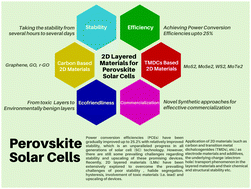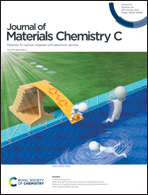Application of two-dimensional materials in perovskite solar cells: recent progress, challenges, and prospective solutions
Abstract
Perovskite solar cells (per-SCs) with high performance and cost-effective solution processing have been the center of interest for researchers in the past decade. Power conversion efficiencies (PCEs) have been gradually improved up to 25.2% with relatively improved stability, which is an unparalleled progress in all generations of solar cell (SC) technology. However, there are still some prevailing challenges regarding the stability and upscaling of these promising devices. Recently, 2D layered materials (LMs) have been extensively explored to overcome the prevailing challenges of poor stability (under moisture, light soaking and high temperature), halide segregation, hysteresis, involvement of toxic materials (i.e., lead), and upscaling of devices. A critical review addressing the recent developments in the use of 2D materials, especially transition metal dichalcogenides (TMDCs), is hence necessary. The development of novel synthesis and deposition techniques including liquid-metal synthesis and ultrasonic assisted spray pyrolysis has offered more efficient fabrication of 2D-LMs with controlled thickness and morphology. Effective functionalization approaches to increase the dispersability of 2D-LMs in non-polar solvents has boosted their potential application in solar cell technology as well. Moreover, compositing 2D TMDCs with suitable organic/inorganic compounds has enabled superior charge kinetics in all functional parts of per-SCs. In addition, newly developed materials such as graphyne and graphdyine along with 2D metal organic frameworks (MOFs) and covalent organic frameworks (COFs) have been employed in per-SCs to achieve PCEs up to 20%. This review summarizes the recent progress and challenges in the application of 2D-LMs in per-SCs and outlines the future pathways to further extend the PCE of per-SCs beyond 25%. This review particularly focuses on 2D-LMs as electrode materials and additives, the underlying charge (electron–hole) transport phenomenon in the functional layers, and their chemical and structural stability.

- This article is part of the themed collection: Journal of Materials Chemistry C Recent Review Articles


 Please wait while we load your content...
Please wait while we load your content...